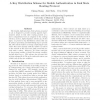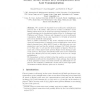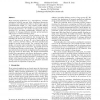133 search results - page 17 / 27 » On the security of linear consensus networks |
IACR
2011
12 years 7 months ago
2011
We aim at constructing adaptive oblivious transfer protocols, enjoying fully simulatable security, from various well-known assumptions such as DDH, d-Linear, QR, DCR, and LWE. To t...
CORR
2007
Springer
13 years 7 months ago
2007
Springer
An encounter-based network is a frequently-disconnected wireless ad-hoc network requiring nearby neighbors to store and forward data utilizing mobility and encounters over time. U...
IPCCC
2005
IEEE
14 years 1 months ago
2005
IEEE
The Double Authentication (DA) scheme presented in [1] is designed to provide security against impersonation attack to link state routing protocol at a lower computational cost as...
EUROCRYPT
2007
Springer
14 years 1 months ago
2007
Springer
We consider the standard secure multi-party multiplication protocol due to M. Rabin. This protocol is based on Shamir’s secret sharing scheme and it can be viewed as a practical ...
SIGCOMM
1998
ACM
14 years 5 hour ago
1998
ACM
Many emerging applications (e.g., teleconference, real-time information services, pay per view, distributed interactive simulation, and collaborative work) are based upon a group ...



